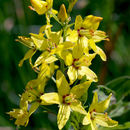fi
nimet breadcrumb-navigoinnissa


Planhigyn blodeuol o deulu'r friallen yw Trewyn America sy'n enw gwrywaidd. Mae'n perthyn i'r teulu Primulaceae. Yr enw gwyddonol (Lladin) yw Lysimachia terrestris a'r enw Saesneg yw Lake loosestrife.[1] Ceir enwau Cymraeg eraill ar y planhigyn hwn gan gynnwys Trewynyn y Llyn.
Mae'n llysieuyn lluosflwydd ac mae fwy neu lai'n fytholwyrdd. Lleolir y dail gyferbyn ei gilydd neu wrth y bonyn. Mae'r blodau, sy'n ddeuryw yn glwstwr taclus ar y prif fonyn. Ceir 5 petal, briger a sepal ar bob blodyn.
Planhigyn blodeuol o deulu'r friallen yw Trewyn America sy'n enw gwrywaidd. Mae'n perthyn i'r teulu Primulaceae. Yr enw gwyddonol (Lladin) yw Lysimachia terrestris a'r enw Saesneg yw Lake loosestrife. Ceir enwau Cymraeg eraill ar y planhigyn hwn gan gynnwys Trewynyn y Llyn.
Mae'n llysieuyn lluosflwydd ac mae fwy neu lai'n fytholwyrdd. Lleolir y dail gyferbyn ei gilydd neu wrth y bonyn. Mae'r blodau, sy'n ddeuryw yn glwstwr taclus ar y prif fonyn. Ceir 5 petal, briger a sepal ar bob blodyn.
Lysimachia terrestris (swamp candles, lake loosestrife[2] or earth loosestrife) is a plant[3] in the family Primulaceae.
Lysimachia terrestris is a herbaceous plant with opposite, simple leaves, and erect stems. The flowers are produced in a raceme, 10–30 cm (4–12 in) long, at the top of the plant.[4] The flowers are star-shaped with five yellow petals, and appear in mid-summer. Each petal has two red dots at its base forming a circle of ten red dots in the center of the flower. Late in the summer, reddish bulblets form in the leaf axils. They resemble caterpillars and may be mistaken for fruit.
Lysimachia terrestris grows in swamps and at the edges of ponds and lakes in the Eastern United States and in Eastern Canada. It is also found in the U.S. states of Oregon, Washington, and Idaho, and in British Columbia.[4] It is listed as endangered in Tennessee and Kentucky.
A major pest is Monostegia abdominalis, a sawfly larva that can completely skeletonize the leaves.
Lysimachia terrestris (swamp candles, lake loosestrife or earth loosestrife) is a plant in the family Primulaceae.
Lysimaque terrestre
La Lysimaque terrestre, Lysimachia terrestris (L) B.S.P., est une espèce de plantes de la famille des Primulaceae. Cette plante est présente en Amérique du Nord, notamment au Québec, dans les zones humides. Parfois, elle ne produit que des bulbilles allongées à l'aisselle des feuilles, ce qui trompa Linné qui crut avoir affaire à un gui terrestre qu'il nomma Viscum terrestris, ce qui explique le nom spécifique actuel de cette lysimaque.
Selon The Plant List (3 juin 2014)[2] :
Selon Tropicos (3 juin 2014)[1] (Attention liste brute contenant possiblement des synonymes) :
Lysimaque terrestre
La Lysimaque terrestre, Lysimachia terrestris (L) B.S.P., est une espèce de plantes de la famille des Primulaceae. Cette plante est présente en Amérique du Nord, notamment au Québec, dans les zones humides. Parfois, elle ne produit que des bulbilles allongées à l'aisselle des feuilles, ce qui trompa Linné qui crut avoir affaire à un gui terrestre qu'il nomma Viscum terrestris, ce qui explique le nom spécifique actuel de cette lysimaque.
Lysimachia terrestris là một loài thực vật có hoa trong họ Anh thảo. Loài này được (L.) Britton, Sterns & Poggenb. mô tả khoa học đầu tiên năm 1888.[1]
Lysimachia terrestris là một loài thực vật có hoa trong họ Anh thảo. Loài này được (L.) Britton, Sterns & Poggenb. mô tả khoa học đầu tiên năm 1888.